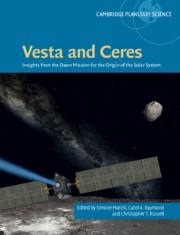Book contents
- Vesta and Ceres: Insights from the Dawn Mission for the Origin of the Solar System
- Cambridge Planetary Science
- Vesta and Ceres
- Copyright page
- Contents
- Contributors
- Preface
- Part I Remote Observations and Exploration of Main Belt Asteroids
- 1 Remote Observations of the Main Belt
- 2 Exploring Vesta and Ceres
- Part II Key Results from Dawn’s Exploration of Vesta and Ceres
- Part III Implications for the Formation and Evolution of the Solar System
- Index
- Plate Section (PDF Only)
- References
2 - Exploring Vesta and Ceres
from Part I - Remote Observations and Exploration of Main Belt Asteroids
Published online by Cambridge University Press: 01 April 2022
- Vesta and Ceres: Insights from the Dawn Mission for the Origin of the Solar System
- Cambridge Planetary Science
- Vesta and Ceres
- Copyright page
- Contents
- Contributors
- Preface
- Part I Remote Observations and Exploration of Main Belt Asteroids
- 1 Remote Observations of the Main Belt
- 2 Exploring Vesta and Ceres
- Part II Key Results from Dawn’s Exploration of Vesta and Ceres
- Part III Implications for the Formation and Evolution of the Solar System
- Index
- Plate Section (PDF Only)
- References
Summary
In 1992, NASA’s planetary efforts were invigorated with the launch of the Discovery Program of principal investigator-led missions. Over the next eight years, a group of planetary scientists and engineers gathered regularly to design and propose to NASA solar-electric propulsion missions targeted to various scientifically important bodies. Ultimately, Dawn, a mission to orbit and explore both Vesta and Ceres, was selected for flight in 2001. It launched in 2007, arrived at Vesta in July 2011, and departed in September 2012 for Ceres. Arrival at Ceres occurred in March 2015, where Dawn operated productively until 31 October 2018, when it exhausted its attitude control propellant. Herein, we summarize the history of Dawn and recount the observations and discoveries made by this pioneering mission.
Keywords
- Type
- Chapter
- Information
- Vesta and CeresInsights from the Dawn Mission for the Origin of the Solar System, pp. 26 - 38Publisher: Cambridge University PressPrint publication year: 2022

